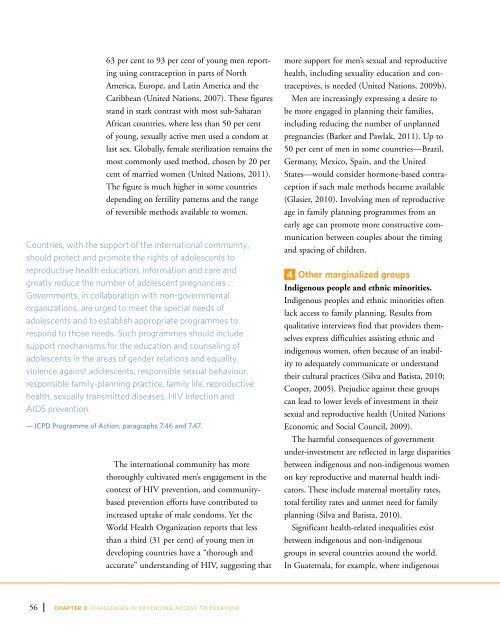State of World Population 2012 - Country Page List - UNFPA
State of World Population 2012 - Country Page List - UNFPA
State of World Population 2012 - Country Page List - UNFPA
You also want an ePaper? Increase the reach of your titles
YUMPU automatically turns print PDFs into web optimized ePapers that Google loves.
63 per cent to 93 per cent <strong>of</strong> young men reporting<br />
using contraception in parts <strong>of</strong> North<br />
America, Europe, and Latin America and the<br />
Caribbean (United Nations, 2007). These figures<br />
stand in stark contrast with most sub-Saharan<br />
African countries, where less than 50 per cent<br />
<strong>of</strong> young, sexually active men used a condom at<br />
last sex. Globally, female sterilization remains the<br />
most commonly used method, chosen by 20 per<br />
cent <strong>of</strong> married women (United Nations, 2011).<br />
The figure is much higher in some countries<br />
depending on fertility patterns and the range<br />
<strong>of</strong> reversible methods available to women.<br />
Countries, with the support <strong>of</strong> the international community,<br />
should protect and promote the rights <strong>of</strong> adolescents to<br />
reproductive health education, information and care and<br />
greatly reduce the number <strong>of</strong> adolescent pregnancies …<br />
Governments, in collaboration with non-governmental<br />
organizations, are urged to meet the special needs <strong>of</strong><br />
adolescents and to establish appropriate programmes to<br />
respond to those needs. Such programmes should include<br />
support mechanisms for the education and counseling <strong>of</strong><br />
adolescents in the areas <strong>of</strong> gender relations and equality,<br />
violence against adolescents, responsible sexual behaviour,<br />
responsible family-planning practice, family life, reproductive<br />
health, sexually transmitted diseases, HIV infection and<br />
AIDS prevention.<br />
— ICPD Programme <strong>of</strong> Action, paragraphs 7.46 and 7.47.<br />
The international community has more<br />
thoroughly cultivated men’s engagement in the<br />
context <strong>of</strong> HIV prevention, and communitybased<br />
prevention efforts have contributed to<br />
increased uptake <strong>of</strong> male condoms. Yet the<br />
<strong>World</strong> Health Organization reports that less<br />
than a third (31 per cent) <strong>of</strong> young men in<br />
developing countries have a “thorough and<br />
accurate” understanding <strong>of</strong> HIV, suggesting that<br />
more support for men’s sexual and reproductive<br />
health, including sexuality education and contraceptives,<br />
is needed (United Nations, 2009b).<br />
Men are increasingly expressing a desire to<br />
be more engaged in planning their families,<br />
including reducing the number <strong>of</strong> unplanned<br />
pregnancies (Barker and Pawlak, 2011). Up to<br />
50 per cent <strong>of</strong> men in some countries—Brazil,<br />
Germany, Mexico, Spain, and the United<br />
<strong>State</strong>s—would consider hormone-based contraception<br />
if such male methods became available<br />
(Glasier, 2010). Involving men <strong>of</strong> reproductive<br />
age in family planning programmes from an<br />
early age can promote more constructive communication<br />
between couples about the timing<br />
and spacing <strong>of</strong> children.<br />
4 Other marginalized groups<br />
Indigenous people and ethnic minorities.<br />
Indigenous peoples and ethnic minorities <strong>of</strong>ten<br />
lack access to family planning. Results from<br />
qualitative interviews find that providers themselves<br />
express difficulties assisting ethnic and<br />
indigenous women, <strong>of</strong>ten because <strong>of</strong> an inability<br />
to adequately communicate or understand<br />
their cultural practices (Silva and Batista, 2010;<br />
Cooper, 2005). Prejudice against these groups<br />
can lead to lower levels <strong>of</strong> investment in their<br />
sexual and reproductive health (United Nations<br />
Economic and Social Council, 2009).<br />
The harmful consequences <strong>of</strong> government<br />
under-investment are reflected in large disparities<br />
between indigenous and non-indigenous women<br />
on key reproductive and maternal health indicators.<br />
These include maternal mortality rates,<br />
total fertility rates and unmet need for family<br />
planning (Silva and Batista, 2010).<br />
Significant health-related inequalities exist<br />
between indigenous and non-indigenous<br />
groups in several countries around the world.<br />
In Guatemala, for example, where indigenous<br />
56 CHAPTER 3: CHALLENGES IN EXTENDING ACCESS TO EVERYONE
















